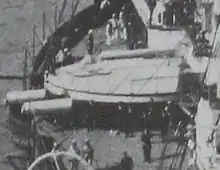RML 16-inch 80-ton gun
RML 16-inch 80-ton guns were large rifled muzzle-loading guns intended to give the largest British battleships parity with the large guns being mounted by Italian and French ships in the Mediterranean Sea in the 1870s.
| Ordnance RML 16-inch 80-ton gun | |
|---|---|
 Port/forward turret on HMS Inflexible | |
| Type | Naval gun |
| Place of origin | United Kingdom |
| Service history | |
| In service | 1880–1902 |
| Used by | Royal Navy |
| Wars | Bombardment of Alexandria (1882) |
| Production history | |
| Designer | Royal Gun Factory |
| Designed | 1874 |
| Manufacturer | Royal Arsenal |
| Unit cost | £10,000[1] |
| No. built | 8 |
| Variants | Mk I |
| Specifications | |
| Barrel length | 288 inches (7.3 m) (bore)[2] |
| Shell | 1,684 pounds (763.8 kg) Palliser, common, Shrapnel[2] |
| Calibre | 16-inch (406.4 mm) |
| Muzzle velocity | 1,590 feet per second (480 m/s)[3] |
| Maximum firing range | 8,000 yards (7,300 m)[4] |
Design and history

The gun was constructed of a toughened mild steel inner "A" tube surrounded by multiple wrought-iron coils, breech-piece and jacket. Rifling was of the "polygroove plain section" type, with 33 grooves increasing from 0 to 1 turn in 50 calibres (i.e. 1 turn in 800 inches) at the muzzle.[2]
After a long design and experimentation period beginning in 1873, HMS Inflexible with four guns became the only ship to mount them, in 1880. By that time such muzzle-loading guns were already obsolescent and were being superseded by a new generation of rifled breechloading guns.
Two more guns were mounted for coastal defence in the Admiralty Pier Turret at Dover.
Ammunition
This was a second-generation RML gun, equipped with polygroove rifling and firing only studless ammunition and using automatic gas-checks for rotation.
 112½-pound ¼ charge brown prism powder cartridge
112½-pound ¼ charge brown prism powder cartridge
Surviving examples

The only two remaining example are in the ruins of the Admiralty Pier Turret, Dover, Kent, UK.
See also
Notes and references
- Brassey 1882, Page 95
- Text Book of Gunnery 1887, Table XVI
- 1590 feet/second firing a 1684-pound projectile, with a charge of 450 pounds Prismatic brown powder (gunpowder). Text Book of Gunnery 1887, Table XVI. The original charge was 450 pounds of prismatic black powder giving a muzzle velocity of 1604 feet/second, but this damaged the barrels and was replaced by brown powder from April 1885. N.J.M. Campbell, "British Super-Heavy Guns".
- Text Book of Gunnery 1902, Table XII. This was the maximum practical range at the low elevations used for firing armour-piercing projectiles on a flat trajectory intended to pierce the armoured sides of ships. Longer ranges would have been attained at higher elevations, but the armour-piercing properties would have been diminished at the lower terminal velocity and oblique angle of impact.
Bibliography
- Text Book of Gunnery, 1887. London: Printed for His Majesty's Stationery Office, by Harrison and Sons, St. Martin's Lane
- Text Book of Gunnery, 1902. London: Printed for His Majesty's Stationery Office, by Harrison and Sons, St. Martin's Lane
- Sir Thomas Brassey, The British Navy, Volume II. London: Longmans, Green and Co. 1882
- N.J.M. Campbell, British Super-Heavy Guns
External links
| Wikimedia Commons has media related to RML 16 inch 80 ton naval gun. |
- Flickr photos of the guns in the Dover turret :
- Photograph of Palliser projectile at Royal Marines Museum, Portsmouth, from Flickr